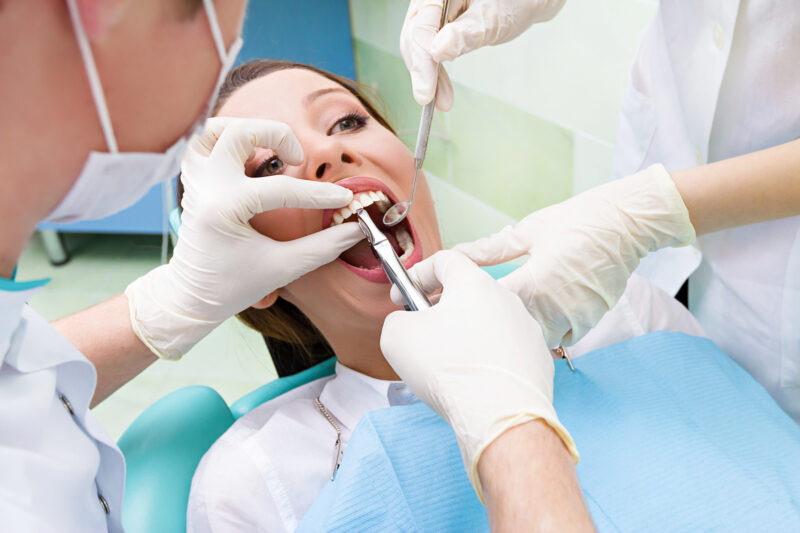
Tooth extractions are among the most frequently performed dental procedures. Also, they are often recommended to preserve and enhance a patient’s oral health.
A routine dental extraction procedure may be recommended for loose, damaged, or decayed teeth. However, for more complex cases it may be necessary for a surgical dental extraction procedure.
Whether you are dealing with impacted wisdom teeth, a broken tooth extraction procedure, or preparing for implants, understanding the process can ease anxiety and ensure successful outcomes.
Pannu Dental Group can ease your mind and answer all your questions.
Today, we will explore the full scope of surgical dental extractions—including reasons behind an extraction, and what to expect during and after surgery. We will also investigate some options, like same-day tooth extraction and implant procedures.
When is a Dental Extraction Procedure Needed?
Tooth extractions are often prescribed when a tooth cannot be restored with a filling, crown, or root canal.
Common reasons for a tooth extraction include:
- Severe tooth decay or infection
- Advanced gum disease
- Orthodontic preparation (removing overcrowded teeth)
- Fractured teeth
- Impacted or partially erupted wisdom teeth
When a tooth is easily accessible and can be removed with forceps, a simple tooth extraction procedure is performed. However, when the tooth is impacted, broken, or lies beneath the gumline, a surgical approach is required.
What is a Surgical Dental Extraction Procedure?
A surgical dental extraction procedure is the removal of teeth that cannot be extracted through a simple tooth extraction treatment.
It typically involves:
- Making an incision into the gum tissue
- Removing bone around the tooth (if necessary)
- Sectioning the tooth into smaller pieces for easier removal
Unlike a basic tooth extraction procedure, surgical extractions require specialized training, tools, and sedation methods. They are best performed by oral surgeons or highly experienced general dentists, like the team at Pannu Dental Group.
Reasons for Surgical Dental Extractions
Several scenarios call for a surgical extraction, which includes the following:
- Impacted wisdom teeth that haven’t erupted through the gum
- Broken tooth extraction procedures where the tooth has fractured below the surface
- Retained roots or curved tooth roots that prevent simple removal
- Teeth needing removal to accommodate dentures or implants
These cases require careful planning, advanced imaging, and sometimes coordination with restorative procedures like implants or bridges.
Step-by-Step Guide to the Surgical Dental Extraction Procedure
Understanding what happens before, during, and after a surgical dental extraction procedure can help prepare patients for a smooth experience and a peace of mind on what to expect. Though treatments certainly vary on a case-by-case basis, a surgical dental extraction procedure entails the following.
1. Pre-Operative Phase
Before the extraction, your dentist or oral surgeon will:
- Conduct a thorough dental exam
- Take X-rays to assess tooth structure and surrounding bone
- Review your medical history, especially related to bleeding disorders, medications, and allergies
- Discuss sedation or anesthesia options: local anesthesia, IV sedation, or general anesthesia may be offered depending on the complexity of the case and patient comfort
2. During the Procedure
The surgical process involves several steps:
- The area is numbed using anesthesia
- A small incision is made in the gum tissue
- Bone covering the tooth may be removed
- The tooth is extracted in one piece or sectioned for easier removal
- Stitches may be placed to aid healing
The entire procedure typically takes 45–90 minutes, depending on the complexity and the number of teeth involved.
3. Post-Operative Recovery
Recovery varies, but here’s what most patients can expect:
- Swelling and mild discomfort for 2–3 days
- Use of prescribed or over-the-counter pain medication
- Ice packs to reduce swelling
- A soft diet for the first few days
- Avoidance of smoking, alcohol, and vigorous rinsing
Complete healing of the extraction site can take several weeks. We also advise patients to maintain gentle oral hygiene and attend follow-up appointments to ensure a smooth recovery process.
Wisdom Tooth Extraction Procedure
The wisdom tooth extraction procedure is one of the most common surgical extractions performed today. Wisdom teeth, or third molars, often become impacted due to a lack of space in the jaw.
If left untreated, impacted wisdom teeth can lead to:
- Pain and swelling
- Gum infections
- Tooth crowding
- Cysts or damage to adjacent teeth
How Long is a Wisdom Tooth Extraction Procedure?
One of the most common questions asked is, ‘How long is a wisdom tooth extraction procedure?’ The answer depends on the number of teeth and their position.
However, most extractions take between 30 minutes to one hour. Recovery usually spans 3–5 days, with full healing taking several weeks until a patient is 100% back to normal.
Emergency Tooth Extraction: When Time Is Critical
An emergency tooth extraction is performed when immediate removal is necessary to alleviate pain or prevent serious complications.
Common Reasons for Emergency Extractions:
- Severe dental infections or abscesses
- Unmanageable tooth pain
- Trauma or broken teeth from accidents
- Swelling or fever indicating systemic infection
Clinics like Pannu Dental Group specialize in emergency tooth extraction and can often provide same-day care. It is important to start with a caring consultation, avoid eating before sedation (if applicable), and follow all aftercare instructions carefully.
Same Day Tooth Extraction and Implant – Is It Possible?
One of the most exciting advancements in restorative dentistry is the ability to perform same-day tooth extraction and implant procedures. Also known as immediate implant placement, this method involves placing a dental implant directly into the socket after a tooth is removed.
When is Same-Day Implant Placement Viable?
Same-day implants may be possible when:
- The extracted tooth is in the front (aesthetic zone)
- The patient has good bone quality and no active infection
- The gum and surrounding tissues are healthy
- The patient is a non-smoker and generally healthy
Advantages of Same-Day Dental Extraction and Implant Procedure:
- Faster treatment and fewer appointments
- Preservation of bone and gum tissue
- Reduced risk of bone loss or shifting teeth
- Immediate aesthetic and functional results (temporary crown may be placed)
Keep in mind that not every patient is a candidate for a same-day extraction. Thorough evaluation and planning are necessary to ensure long-term success.
Trust Pannu Dental Group for Surgical Extractions and Implants
Whether you’re facing a wisdom tooth extraction procedure, managing a dental emergency, or exploring same-day tooth extraction and implant options, Pannu Dental Group offers comprehensive solutions with patient comfort and care in mind.
Our experienced team specializes in surgical dental extraction procedures, from pre-operative evaluation to follow-up care.
If you require a dental extraction and implant procedure, our state-of-the-art clinics and advanced technology and tools ensure that treatment is timely, precise, and tailored to your needs.
Contact Pannu Dental Group today and take the first step toward a healthier, more confident smile.
Schedule your consultation today.
Dr. Dalvir S. Pannu has been a practicing dentist since 1995. In 1996 he opened his first dental practice in India, where he gained invaluable experience and acumen. In October of 1997 he was invited by the American Dental Association (ADA) to present the table clinic on Endodontics, at their annual session held in Washington, D.C. At this time he fell in love with the United States and became passionate about practicing dentistry in California. He became particularly enamored of the San Francisco Bay area, and soon took up residence and work here.
